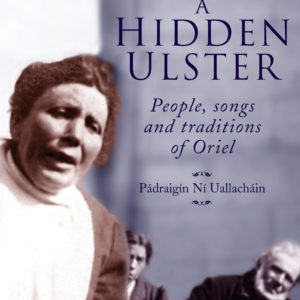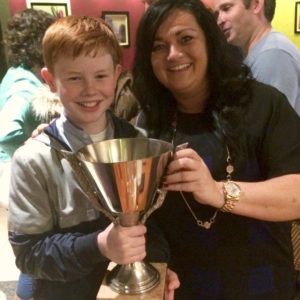A Hidden Ulster – book
A final, limited and updated print of ‘A Hidden Ulster’ was published by Ceoltaí Éireann in December 2023. Order Now
‘A momentous publication … a treasure trove of words, a cultural and social history, a work of great tenderness and bighearted loyalty. Proud and heartbroken, it is an heroic attempt to remember.’
Michael Longley

Michael Longley and Pádraigín Ní Uallacháin
A Hidden Ulster – people, songs and traditions of Oriel by Pádraigín Ní Uallacháin – now in its third print – was published by Four Courts Press (Dublin) in 2003, to widespread critical acclaim. Shortlisted for the 2005 Michaelis-Jena Ratcliff Prize in Folklore and Folklife, it was also listed among the Books of the Year both in the London Times and the Irish Times.
It was launched in the National Library Dublin, by Cathal Goan, in the Linen Hall Library Belfast by the poet Michael Longley and Dr Pól Ó Muirí, in Oriel by Dr Diarmaid Ó Doibhlin and Dr Tom Collins, and by Dr Tom Munnelly at the Clare Festival of Traditional Singing 2003.
Song
 As the song tradition does not exist in isolation, this research places it at the heart of the social life of the people with its traditions, singers, musicians and rituals, which are chronicled and recalled in great detail. Much of this material survived in disparate, fragmentary form, mainly hidden away in libraries, archives, museums and private collections, and in most instances the song airs were lost, but following extensive research by the author, who is also a traditional singer, a once vibrant and vital song tradition was recreated.
As the song tradition does not exist in isolation, this research places it at the heart of the social life of the people with its traditions, singers, musicians and rituals, which are chronicled and recalled in great detail. Much of this material survived in disparate, fragmentary form, mainly hidden away in libraries, archives, museums and private collections, and in most instances the song airs were lost, but following extensive research by the author, who is also a traditional singer, a once vibrant and vital song tradition was recreated.
Harp

Patrick Byrne 1876- 1883. Photographc.1843
Another feature of this work is the inextricable link between the literary, song and harp tradition, showing poets and harpers in close collaboration (AHU pp.337-57), and songs of the poets and the people surviving in the harpers repertoire collected by Edward Bunting c.1800 (AHU p.372-3). Included were detailed biographical information on poets and harpers from c.1650 – 1863. It shows how both genres can inform each other in relation to repertoire and interpretation.
Tunes

Fiddler in Oriel 1912
Although Oriel is known as an area very rich in traditional music, other collections emerged during research that had not been published before in mainstream collections, notably the Patrick McGahon and Luke Donnellan collections (AHU pp.435-507). They are published in A Hidden Ulster in manuscript facsimile form, and are finding a way back again into the national repertoire of tunes. There is an extensive list of the repertoire of a piper called Philip Goodman, as well as song airs and tunes published in the County Louth Archaeological Journal.
People
Due respect and credit is paid to the last keepers of the oral Gaelic tradition in Oriel – singers and storytellers and the many collectors, photographers and transcribers who had the wisdom, patience and endurance to record these valuable treasures for posterity (AHU pp. 358-416).
The outcome of this publication is a new awareness in the wider national community of one of Ireland’s richest sources of song and music; a sense of pride and ownership in the local community of a noble and ancient inheritance; a plethora of television and radio documentaries, recordings, new research, awards and events celebrating this magnificent national treasure trove has followed.
Sections of A Hidden Ulster have been reprinted in various literary anthologies, and it is essential reading on the music, language, anthropology and folklore courses in various faculties of third level institutions throughout Ireland.
AWARDS for the SONG TRADITION OF ORIEL
There is a consistent and growing recognition for the renewed song tradition of Oriel. A once almost lost tradition, during the latter part of the 20th century, it is once again vibrant and vital, with established sean-nos singers from Donegal sourcing songs from Oriel, young local singers sourcing songs from this website, Oriel Arts, from the CD of 27 Oriel songs, CEOLTAÍ OIRIALLA and the source publication, A Hidden Ulster – people,songs and traditions of Oriel, which is now going into its 3rd reprint; and contemporary singers such as Rioghnach Connolly sourcing songs from the Ceoltaí Oirialla CD and singing them on the international stage.
The songs are being taught to young singers in the local Gaelscoil in Crossmaglen by singer Bláithín Mhic Cana with occasional masterclasses given by singers Padraigín Ní Uallacháin, Máire Ní Choilm and other invited Donegal singers to the area, such as Mairead Ní Mhaonaigh.
With a growing proud and confident reclamation of the local tradition, young Oriel singers are now taking part in Sean-Nós competitons – both national and regional – which were once the domain of Gaeltacht singers only, and are now returning home with a cross generational crop of national awards.
Oirialla Sean-Nós at Oireachtas na Gaeilge

Piaras Ó Lorcáin, from County Armagh, receiving Corn Cuimhneacháin Sheosamh Úi Éanaí trophy for sean-nós singing from singer Diane Cannon Oireachtas na Gaeilge 2016
When young Piaras Ó Lorcáin, from south Armagh, won the Corn Cuimhneacháin Sheosaimh Uí Éanaí trophy in the national Oireachtas na Gaeilge sean-nós competion 2016, singing the old renewed version of Séamus Mac Murfaidh (from on An Dealg Óir CD and A Hidden Ulster), competing against the finest of young Gaeltacht sean-nós singers, it was symbolic of the work having come full circle.
Feilimí O’Connor had paved the way for Piaras and other Oriel singers when he won Corn Cuimhneacháin Amhránaithe Sean-Nóis Mhúscraí trophy in his category in 2015, singing A Hidden Ulster songs which he learned from his mother, Eithne Ní Uallacháin. He turned the tide of sean-nós singing by bringing an Oireachtas na Gaeilge sean-nós award to Oriel for the first time.

Feilimí O’Connor from County Louth, winner of 2015 Oireachtas na Gaeilge sean-nós trophy Corn Cuimhneacháin Amhránaithe Sean-Nóis Mhúscraí.
As a result of the publication of A Hidden Ulster and the recording of renewed songs from manuscript, Ceoltaí Oirialla, CD a once tenuous, fragile, ancient tradition is becoming more accessible and enjoyed by a younger community and also generating informed scholarship and performance, with a renewed confidence and a vibrancy in the Gaelic oral traditions of Oriel.
ORIEL ARTS aims to replenish the well, by bringing elements of this great Oriel legacy full circle, and returning it back to the community – restored and renewed.
A Hidden Ulster -people, songs and traditions of Oriel is available on order from Four Courts Press, Dublin: http://www.fourcourtspress.
GRADAM TG4 Traditional Music Awards 2018

Actor Stephen Rea presents Padraigín Ní Uallacháin with GRADAM TG4 Award in Waterfront Hall Belfast 2018.
The Director of Oriel Arts, author of A Hidden Ulster, and Oriel Sean-Nós singer Padraigín Ní Uallacháin was honoured with GRADAM TG4 2018 ‘Outstanding Contribution to Irish Traditional Music‘, for her renewal of the Oriel song tradition and her many new compositions in the traditional style. During 2018, in recognition of her contribution to Oriel Arts, she received local cultural awards from CLG An Mullach Bán, Newry, Mourne & Down Civic award, Conradh na Gaeilge, Arás Mhic Ardghail ‘Newry, ‘Mná an Mhisnigh’ award, and Fiddlers Green Creative Cultural Award 2018.
For the Gradam TG4 presentation in the Waterfront Hall Belfast, she invited local singers Blaithín Mhic Cana and Piaras Ó Lorcáin to join her in singing in unison the renewed Oriel song Seamus Mac Murfaidh
https://www.youtube.com/watch?v=6DfYXqt09Ys

Piaras Ó Lorcáin winner of Sean-Nós (12-15) Fleadh Cheoil na hÉIreann Drogheda 2018

Oriel Sean-Nós singers Piaras Ó Lorcáín & Bláíthín Mhic Cana with An tUachtarán Michael D. Higgins Waterfron Hall Belfast 2018 GRADAM TG4 Awards
SEAN NÓS AWARDS 2018 & 2019
Following his appearance in the Waterfront Hall in Belfast for GRADAM TG4 Awards, and meeting with Uachtaran na hÉireann, Michael D. Higgins, Piaras Ó Lorcáin went on to win the top award in his category in Sean-Nós singing (12-15_ at Fleadh Cheoil na hÉireann in Drogheda, singing the renewed Oriel version of An Bonnán Buí.

Cullyhanna Sean-Nós singer, Síomha Ní Ghribín, winner of Corn Mhic Reachtain in Áras Mhic Reachtain Belfast 2019, with Donegal sean-nos singer Doiminic Mac Giolla Bhride.
Oirialla sean nós singers continue to scoop two mayor awards at the annual Sean Nós na Fearsaide in Áras Mhic Reachtain in Belfast in February with Corn Mhic Reachtain 2019 won by young Cullyhanna singer, Síomha Ní Ghribín, who attends Gaelscoil Phádraig Naofa in Crossmaglen.

Oirialla Sean-Nós singer, Bláithín Mhic Cana winner of Corn Uí Chriagáin in Áras Mhic Reachtain Belfast 2019
Her singing teacher, Bláithín Mhic Cana, one of the singers featured in this renewal project of Oriel Arts, won the major award at the festival Corn Uí Chriagáin 2019, singing the renewed Oriel version of Maidin Fhómhair.
Oriel Arts is immensely proud of their achievements and celebrates the turning of the tide of the Gaelic song tradition of Oriel for generations to come.
